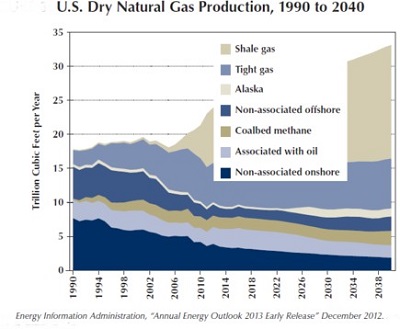Expanded Use Of Natural Gas Can Cut Carbon Emissions
 Increased natural gas use can help reduce U.S. greenhouse gas emissions in the near to medium term, but deeper long-term reductions will require broader deployment of other low-carbon energy sources as well, according to a report released earlier this month by the Center for Climate and Energy Solutions
Increased natural gas use can help reduce U.S. greenhouse gas emissions in the near to medium term, but deeper long-term reductions will require broader deployment of other low-carbon energy sources as well, according to a report released earlier this month by the Center for Climate and Energy SolutionsThe report, “Leveraging Natural Gas to Reduce Greenhouse Gas Emissions,” examines the climate challenges and opportunities posed by the current natural gas boom. U.S. emissions are back down to where they were in the mid-1990s, in part because electricity generators are using more natural gas, which emits half as much carbon dioxide as coal.
The report identifies other opportunities to reduce greenhouse gas emissions by substituting natural gas for coal and oil in the transportation, manufacturing and building sectors.
But the report emphasizes that the climate benefits of increased natural gas use can be maximized only if further steps are taken throughout the natural gas system to reduce leaks of methane, the principal component of natural gas and a potent greenhouse gas.
It also underscores the need for zero-carbon energy sources such as wind, solar and nuclear, and for carbon capture-and-storage technologies, to achieve the deeper emission cuts needed over the longer term.
“The natural gas boom can help grow the economy while shrinking our carbon footprint, and there’s much greater potential on both fronts,” said C2ES President Eileen Claussen.
 “But we need a diverse energy supply. Natural gas is not carbon-free and we can’t let it crowd out nuclear and renewables. It’s also critical that we do a better job of measuring and minimizing methane releases.”
“But we need a diverse energy supply. Natural gas is not carbon-free and we can’t let it crowd out nuclear and renewables. It’s also critical that we do a better job of measuring and minimizing methane releases.”The report synthesizes the findings of a series of background papers and workshops in Houston and Boston attended by several dozen experts and representatives of industry, environmental organizations, and state agencies.
It was funded in part by grants from the American Gas Association and the Clean Skies Foundation.
Following is a summary of opportunities and challenges identified in the report, and key next steps:
Opportunities
*Increased direct use of natural gas in homes and businesses by replacing certain electric appliances, such as space and water heaters, with natural gas models.
*Reduced reliance on petroleum and reduced emissions by substituting natural gas for diesel and gasoline in fleets and heavy-duty trucks.
*Manufacturing growth with reduced emissions by using natural gas in more efficient combined heat and power systems.
*Expanded use of natural gas-powered fuel cells and microturbines producing efficient, on-site energy that makes use of waste heat.
Challenges
*Funding expensive infrastructure to deliver natural gas to more homes and businesses.
*Ensuring that natural gas complements – not crowds out – zero-carbon energy such as nuclear, wind, and solar.
*Overcoming regulatory hurdles and a lack of incentives for on-site (distributed) power generation.
*Identifying and addressing methane leaks from the production, transmission, and distribution of natural gas.
Next steps
*Educating consumers about the full-fuel-cycle efficiency of natural gas appliances.
*Encouraging innovative funding models and incentives to extend natural gas lines to consumers and promote on-site power generation.
*Informing manufacturers about the increased efficiency and resilience of combined heat and power systems.
*Aligning state policies to overcome perceived conflicts between utilities and combined heat and power operations, encourage development of distributed generation technologies such as microturbines, and address the high cost of expanding natural gas infrastructure.
You can return to the main Market News page, or press the Back button on your browser.

